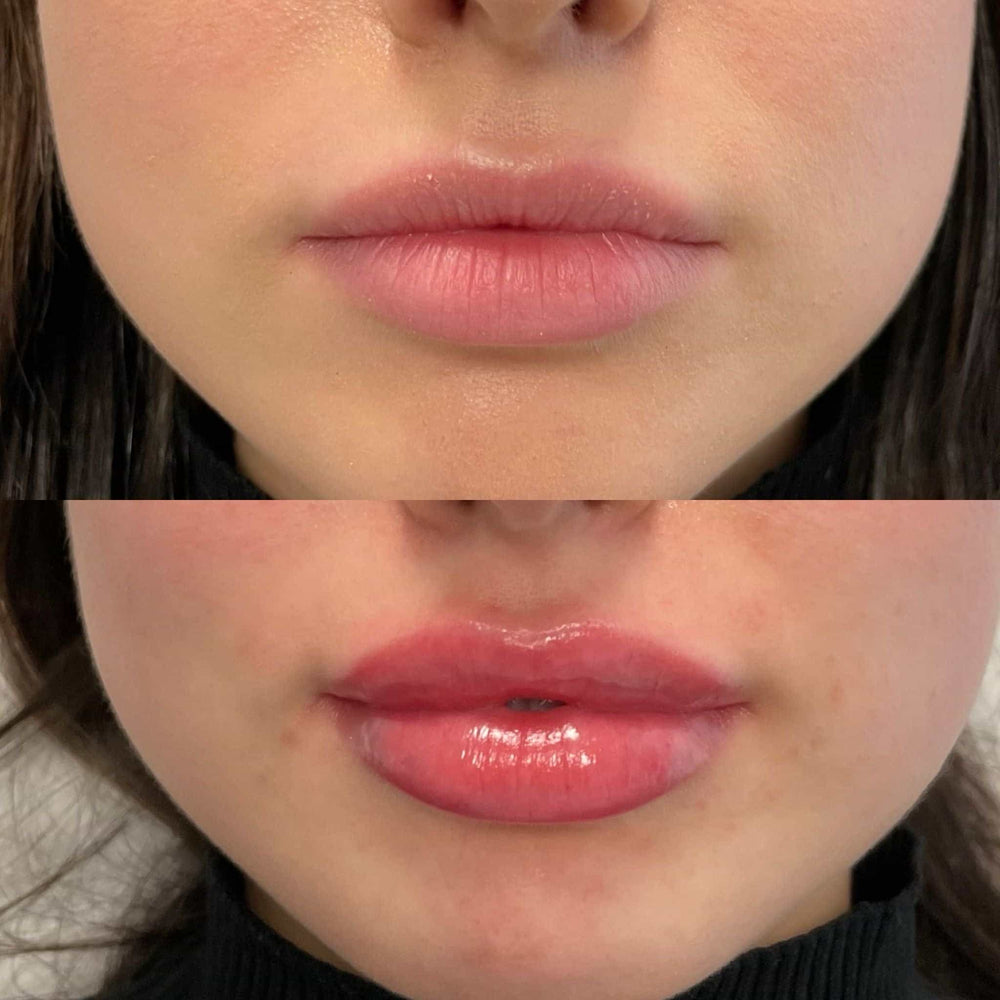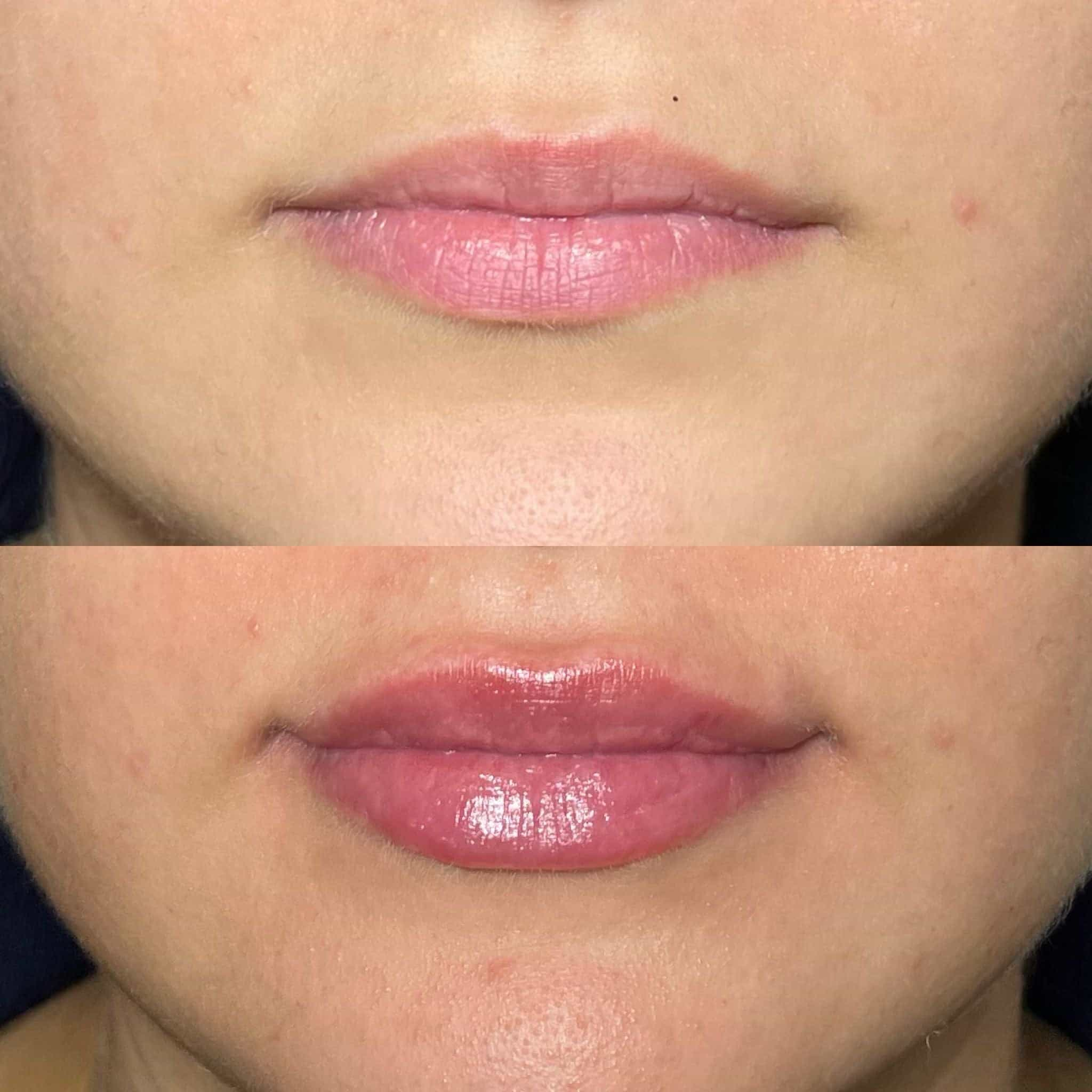Book Your Dermal Filler Appointment with Dr. Laura Geige Today
Factors Affecting Healing Time
Skin Type
Several factors influence how quickly your skin heals after lip filler injections.

One key factor is your individual skin type. Oily skin tends to heal faster than dry or sensitive skin, as it naturally produces more sebum which helps lubricate and protect the skin.
Dry skin lacks this protective barrier and can take longer to recover from any trauma, including injections.
Sensitive skin may also experience prolonged healing due to its predisposition to irritation and inflammation.
Beyond skin type, factors like your overall health, age, medication use (especially blood thinners), sun exposure, and the technique used during the injection can all impact healing time.
It’s essential to follow your injector’s post-treatment instructions carefully to optimize healing and minimize any potential complications.
This typically includes avoiding excessive heat or cold on the treated area, refraining from touching or picking at the injection sites, and protecting your lips from the sun with sunscreen.
If you experience any unusual swelling, redness, pain, or other concerns, contact your injector promptly.
Age and Health
Healing time for lip filler injections varies depending on several factors, including age, overall health, and individual healing capabilities.
**Age** plays a significant role in how quickly your lips heal. Younger individuals typically have faster cell regeneration rates, meaning their bodies recover from procedures like lip fillers more swiftly.
Conversely, as we age, our skin’s elasticity and collagen production decrease, leading to longer healing times. This doesn’t necessarily mean you can’t get lip filler if you’re older; it just means you might experience a slightly extended recovery period.

**Overall health** is another crucial factor affecting healing time. Individuals with compromised immune systems or chronic medical conditions may take longer to heal than those in good health.
Certain medications, such as blood thinners, can also increase bleeding and prolong the healing process.
It’s essential to discuss your medical history and any medications you’re taking with your injector before undergoing lip filler treatment. They can assess your individual situation and provide personalized guidance on healing expectations.
Individual factors like **skin type, lifestyle, and post-procedure care** also contribute to the overall healing time.
Following your injector’s aftercare instructions diligently is crucial for optimal healing. This often includes avoiding strenuous activity, applying ice packs, and moisturizing the area regularly.
By understanding these factors and taking proper care of yourself post-procedure, you can minimize discomfort and promote a smooth healing process.
Type of Filler Used
Determining how long to wait before getting more lip filler depends on several factors, primarily focused on allowing your initial treatment to fully heal and integrate.
One major factor influencing healing time is the **type of filler** used.
Hyaluronic acid (HA) fillers**, like Juvederm or Restylane, are generally known for quicker absorption and less swelling, often requiring 1-2 weeks for initial bruising and swelling to subside.
Conversely, **permanent fillers** can take significantly longer to fully settle. Some may require up to several months before touch-ups are considered.
Beyond filler type, individual healing rates play a significant role. Factors like age, skin condition, metabolism, and overall health can all influence how quickly your body processes the filler.
Additionally, certain lifestyle choices can affect healing. Smoking, alcohol consumption, and excessive sun exposure can impede the body’s natural repair processes, potentially prolonging recovery time.
It’s crucial to consult with a qualified **aesthetic physician** who can assess your individual situation, considering factors like:
- The type and amount of filler used
- Your skin’s natural healing capabilities
- Your overall health and lifestyle habits
They will provide personalized guidance on the optimal time frame for your next treatment, ensuring both safety and desired results.
General Timeline for Top-Ups
Initial Swelling and Bruising
Understanding the timeline for top-ups, initial swelling and bruising after lip filler is crucial for managing your expectations and ensuring optimal results.
**Initial Swelling:** Typically, you can expect noticeable swelling immediately after the procedure. This peak swelling usually occurs within the first **24 to 72 hours**. During this time, ice packs applied regularly can help minimize puffiness.
Bruising is another common side effect that often appears around the injection sites. It usually starts as a faint reddish-purple discoloration and gradually fades over the next few days. Most bruising resolves completely within **5 to 7 days**.
While swelling and bruising subside, your lips may feel slightly tender or numb for a few days. Gentle massage can help improve circulation and reduce any lingering numbness.
**Top-Up Appointments:** The longevity of lip filler varies depending on individual factors like metabolism and the type of filler used. However, as a general guideline, top-up appointments are typically recommended every **6 to 12 months**. This helps maintain fullness and achieve long-lasting results.
It is important to note that your doctor will assess your individual needs and provide personalized advice on the timing of your next top-up appointment. They may recommend an earlier follow-up if needed based on your results.
Full Results Visibility
Determining the ideal time to get more lip filler depends on various factors, including the amount initially injected, individual metabolism and absorption rates, and desired outcome.
Here’s a general timeline for top-ups and full results visibility:
- Initial Results: Immediately after treatment, lips will appear fuller and more defined. This is the peak of swelling.
- Peak Swelling Reduction (7-10 Days): Swelling significantly subsides, revealing a more natural-looking enhancement.
- Full Results Visibility (2-3 Weeks): By this time, most swelling has resolved, and the final shape and volume of your lips become evident.
- Top-up Frequency: Most people experience gradual fading of filler over several months.
It’s common to require top-up appointments every 6 to 12 months, depending on individual needs and desired maintenance level.
Factors that can influence the longevity of lip filler include:
* **Amount Injected:** Larger injections typically last longer than smaller ones.
* **Filler Type:** Different types of fillers have varying lifespans (e.g., hyaluronic acid fillers generally last 6-18 months).
* **Individual Metabolism:** Some people metabolize fillers faster than others.
Remember to consult with a qualified and experienced injector to determine the best course of treatment and top-up schedule for your specific situation.
Optimal Timing for Follow-up Appointments
Lip filler top-ups are crucial to maintaining the fullness and shape you desire.
Here’s a general timeline and optimal timing for follow-up appointments:
- Initial Top-Up (2-4 weeks): This is the first post-injection appointment. Swelling typically subsides by this point, allowing for a more accurate assessment of final results.
- Second Top-Up (6-8 weeks):**
- Subsequent Top-Ups (Every 6-12 months): After the initial two appointments, you’ll need less frequent top-ups. The exact timing depends on factors like individual metabolism, filler type, and desired volume.
The filler continues to integrate with your tissues at this stage. A second top-up can address any minor imperfections or fine-tune the shape further.
Factors Influencing Optimal Timing:
- Filler Type: Different types of fillers have varying lifespans. Hyaluronic acid fillers typically last 6-18 months, while collagen stimulators can offer longer-lasting results.
- Desired Volume and Shape: Those who prefer a more dramatic look may need top-ups more frequently.
- Lifestyle Factors: Smoking, excessive sun exposure, and dehydration can affect filler longevity.
It’s always best to consult with your injector for personalized advice on optimal timing for lip filler top-ups. They can assess your individual needs and recommend a schedule that best suits you.
Signs It’s Time for More Lip Filler
Loss of Volume
It’s natural for lip fillers to gradually dissolve over time, which typically ranges from 6 to 18 months depending on the type of filler used.
While individual results vary, there are several telltale signs that your lips might be showing signs of needing a touch-up:
Loss of Definition:
If you notice the Cupid’s bow (the dip in the center of your upper lip) is less defined or the natural contours of your lips appear less pronounced, it could indicate volume loss.
Thinning Lips:**
When your lips look thinner than they used to, even when you smile, this is a clear sign that filler may be needed. This often occurs as collagen production naturally slows down with age.
**Asymmetrical Lips:**
If one side of your lips appears slightly different in fullness or shape compared to the other, it could signify uneven filler absorption or degradation. A touch-up can help restore symmetry.
Smaller Smile Arch:**
A diminished smile arch is a common sign of volume loss. Your lip lines may appear flatter when you smile, resulting in a less noticeable upturn at the corners of your mouth.
Fine Lines Around the Mouth (Perioral Wrinkles):
As lips lose volume, the skin around the mouth can become more prominent. This can accentuate fine lines and wrinkles surrounding the lips.
If you’re experiencing any of these signs, it might be time to consult with a qualified cosmetic professional to discuss your options for lip enhancement.
Asymmetry or Shifting
Determining when it’s time for more lip filler depends on individual factors like your desired look, injection type, and natural lip movement.
Here are some signs that you might consider getting more lip filler:
-
Volume Loss: Your lips appear less plump or voluminous than desired. This is a natural process as hyaluronic acid, the substance used in most fillers, gradually gets metabolized by the body.
-
Asymmetry or Shifting:** One lip looks noticeably different from the other or filler has migrated to an undesirable area.
-
Loss of Definition: The Cupid’s bow (the dip in the center of your upper lip) and philtrum (the crease between your nose and upper lip) become less defined, making your lips appear flatter.
-
Fine Lines or Wrinkles:**
If the filler initially helped smooth fine lines around your lips, but those wrinkles are becoming more prominent again, a touch-up might be beneficial.
Book Your Dermal Filler Appointment with Dr. Laura Geige Today
Remember that these signs aren’t definitive and it’s best to consult with a qualified and experienced aesthetic provider. They can assess your individual needs, discuss realistic expectations, and recommend the appropriate treatment plan.
Dissatisfaction with Appearance
There’s a fine line between embracing your natural features and feeling the need for enhancement. Dissatisfaction with one’s appearance, particularly facial features like lips, can lead to considering lip fillers as a solution.
Here are some signs it might be time for more lip filler:
-
Your lips have lost their fullness and definition.
-
You feel like your smile doesn’t look as youthful or appealing as before.
-
The shape of your lips has changed, appearing flatter or less symmetrical.
-
Your lip filler has completely dissolved and you desire to restore the previous volume and shape.
It’s important to remember that individual results vary and lip filler effects can fade over time. This is a natural process as hyaluronic acid, the main ingredient in most fillers, gradually breaks down.
If you’re contemplating top-up appointments or revisiting your desired lip look, consult with a qualified and experienced injector. They can assess your individual needs, discuss realistic expectations, and help you achieve your aesthetic goals safely and effectively.
Get a Dermal Filler Consultation with Dr. Laura Geige at It’s Me and You Clinic
Tableau Consulting LLC Mind Plus Motion Arielle Likes to Cook Christina Stambolian
- Lip Flip Treatment Near Redhill, Surrey - May 4, 2025
- Cheek Filler Near Horne, Surrey - May 3, 2025
- Juvederm Volite Skin Booster Treatments Near Brockham, Surrey - May 2, 2025
